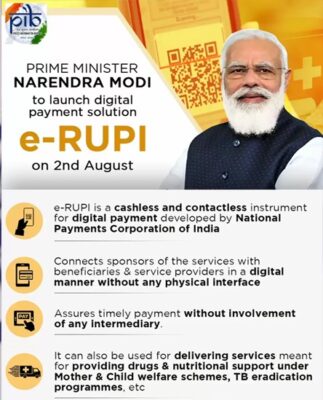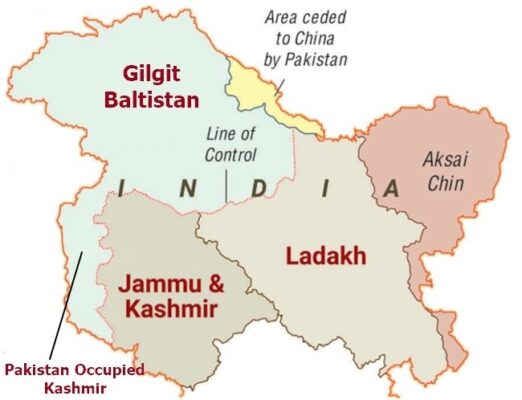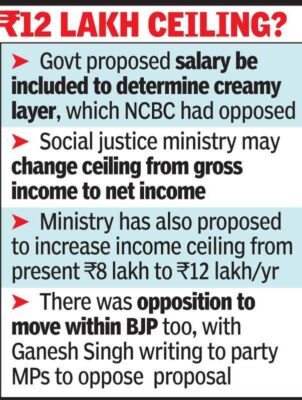- Home
- Prelims
- Mains
- Current Affairs
- Study Materials
- Test Series
02nd Aug 2021
PM MODI TO LAUNCH e-RUPI DIGITAL PAYMENT SOLUTION
Recently, the Prime Minister's Office has announced that the Prime Minister will launch the digital payment solution e-RUPI on 2nd August.
e-RUPI




- It is a person and purpose specific digital payment solution.
- It is a cashless and contactless instrument for digital payment.
- It is a QR code or SMS string-based e-Voucher, which is delivered to the mobile of the beneficiaries.
- It has been developed by National Payments Corporation of India on its UPI platform, in collaboration with the Department of Financial Services, Ministry of Health & Family Welfare and National Health Authority.
- Any corporate or government agency will have to approach the partner banks, which are both private and public-sector lenders, with the details of specific persons and the purpose for which payments have to be made.
- The beneficiaries will be identified using their mobile number and a voucher allocated by a bank to the service provider in the name of a given person would only be delivered to that person.
- It backed by the existing Indian rupee as the underlying asset and specificity of its purpose makes it different to a virtual currency and puts it closer to a voucher-based payment system.
- The users will be able to redeem the voucher without a card, digital payments app or internet banking access, at the service provider.
- It connects the sponsors of the services with the beneficiaries and service providers in a digital manner without any physical interface.
- It ensures that the payment to the service provider is made only after the transaction is completed.
- It assures timely payment to the service provider without involvement of any intermediary.
- It is expected to be a revolutionary initiative in the direction of ensuring a leak-proof delivery of welfare services.
- The newspaper reported that under the proposed law, the Supreme Appellate Court (SAC) of Gilgit-Baltistan may be abolished and the region's election commission is likely to be merged with the Election Commission of Pakistan (ECP).
- The proposed law suggests that due to sensitivity attached to the region, it could be given provisional provincial status by amending Article 1 of the Constitution that related to the provinces and territories.
- It added that a set of amendments would be introduced to give the region representation in Parliament, besides the establishment of the provincial assembly in the territory.
- The constitutional amendment is in accordance with the international practice of merger of territories and it will not adversely affect the Kashmir cause in any manner.
- The region will become the fifth province of Pakistan, although the region is claimed by India as part of the erstwhile princely state of Jammu & Kashmir as it existed in 1947 at its accession to India.

- It is the northernmost territory administered by Pakistan, providing the country's only territorial frontier, and thus a land route, with China, where it meets the Xinjiang Autonomous Region.
- The Gilgit-Baltistan region is surrounded by Afghanistan in west, Pakistan-occupied Kashmir in south, and J&K in east.
- Though Pakistan, like India, links G-B’s fate to that of Kashmir, its administrative arrangements are different from those in PoK.
- While PoK has its own Constitution that sets out its powers and their limits vis-à-vis Pakistan, G-B has been ruled mostly by executive fiat.
- It got its present name only with the Gilgit-Baltistan (Empowerment and Self-Governance) Order, 2009, which replaced the Northern Areas Legislative Council with the Legislative Assembly.
- The NALC was an elected body, but had no more than an advisory role to the Minister for Kashmir Affairs and Northern Areas, who ruled from Islamabad.
- India has clearly conveyed to Pakistan that the entire union territories of Jammu and Kashmir and Ladakh, including the areas of Gilgit and Baltistan, are an integral part of the country by virtue of its fully legal and irrevocable accession.
- India maintains the Government of Pakistan or its judiciary has no locus standi on territories illegally and forcibly occupied by it.
- It is in the Department of Expenditure, Ministry of Finance.
- It is the Principal Accounting Adviser to Government of India.
- It is responsible for establishing and maintaining a technically sound Management Accounting System.
- It prepares monthly and annual analysis of expenditure, revenues, borrowings and various fiscal indicators for the Union Government.
- The Annual Appropriation Accounts (Civil) and Union Finance Accounts are submitted to Parliament under Article 150 of the Constitution.
- Its goal is to provide reliable information that brings transparency in the use and reporting of public funds through an integrated government-wide financial information system.
- It derives his mandate from Article 150 of the Constitution.
- Its statutory mandate as incorporated in the Allocation of Business Rules 1961 brings out the duties and responsibilities of CGA as below:
- General principles of Government accounting relating to Union or State Governments and form of accounts, and framing or revision of rules and manuals relating thereto;
- Reconciliation of cash balance of Union Government with Reserve Bank in general and, in particular, of Reserve Deposits pertaining to Civil Ministries or Departments;
- Overseeing the maintenance of adequate standards of accounting by Central Civil Accounts Offices;
- Consolidation of monthly accounts, preparation of review of trends of revenue realization and significant features of expenditure etc and preparation of annual accounts (including Summary, Civil Appropriation Accounts) showing under the respective heads, the annual receipts and disbursements for the purpose of the Union Government;
- Administration of Central Treasury Rules and Central Government Account (Receipt and Payment Rules 1983);
- Coordination and assistance in the introduction of management accounting system in Civil Ministries or Departments;
- Cadre management of Group ‘A’ (Indian Civil Accounts Service) and Group ‘B’ Officers of the Central Civil Accounts Offices;
- Matters relating to the Central Civil Accounts staff belonging to Group ‘C’ and ‘D’; and
- Disbursement of Pension through Public Sector Banks (PSBs) in respect of Central Civil Pensioners, Freedom Fighters, High Court Judges, Ex-M.P.s and Ex-Presidents.
- It was established by the Government of India in 2015, in pursuance of sub-section (1) of Section 9C of the Mines and Minerals (Development and Regulation) Act, 1957.
- The office of the Trust is situated in the Ministry of Mines, New Delhi.
- It has a two tier structure:
- The apex body is the Governing Body, chaired by the Honorable Minister of Mines. It holds the overall control of the Trust.
- The Executive Committee, chaired by Secretary, Ministry of Mines, administers and manages its activities.
- The NMET Fund receives money from holders of mining lease or a prospecting licence-cum-mining lease, an amount equivalent to two percent of royalty paid in terms of the Second Schedule of the MMDR Act.
- It supports regional and detailed mineral exploration in the country and other activities approved by the Governing Body, to achieve its objects.
- It is a body working to realize the mineral potential of the country in terms of mining activity and contribute commensurately to the growth of national economy.
- The Ministry pointed out that in a resource rich country like India all efforts should be made to give further fillip to mineral exploration so that imports can be curtailed.
- The Ministry stressed upon the need to focus on exploration of gold and rare earths along with other segments of India’s mineral exploration efforts.
- It is important to streamline the system of extending financial assistance to states, especially the mineral rich states for enhanced exploration.
- The NMET fund is being utilized to:
- Undertaking studies for mineral development;
- Regional and detailed exploration with special emphasis to strategic and critical minerals;
- Aerial geophysical survey of obvious geological potential (OGP) and adjoining areas of India; and
- Sustainable mining with adoption of advanced scientific and technological practices and mineral extraction metallurgy.
- It also facilitates exploration activities in such a manner that areas explored can be taken up for grant of mineral concessions in accordance with the provisions of the Act.
- It is an upcoming “ultra low-cost carrier” or ULCC.
- It is being launched by stock market investor Rakesh Jhunjhunwala, who will hold a 40% stake in the airline company.
- It is planned to launch the airline by April 2022, and has on-boarded aviation industry veterans to run the airline.
- The airline expects to be granted a no-objection certificate from the Ministry of Civil Aviation.
- InterGlobe Aviation Ltd-run budget airline IndiGo is India’s largest airline with over 54% market share in the domestic passenger market followed by state-owned Air India, SpiceJet, GoAir, Vistara and AirAsia India.
- GoAir, which has filed papers for its initial public offering, recently rebranded itself to GoFirst and plans to revamp its business model to become a ULCC.
- The upheaval of the Indian airline industry has largely been on the back of deep losses reported in 2020-21 (April-March) because of Covid-19.
- The massive, perennial losses have created a debt trap which has resulted in most airlines having very limited means of recapitalisation.
- In the ULCC airline business model, the company focusses on keeping operating costs even lower than typical budget airlines like IndiGo and SpiceJet.
- In the low-cost model, airlines unbundle certain amenities that are usually associated with the full-service airline experience like seat selection, food and beverages, etc.
- In the ultra low-cost model, there is an even further unbundling of services like checked-in baggage, cabin baggage, etc.
- While LCCs operate with significantly lower fares and only somewhat lower costs than full-service carriers, ULCCs operate with minimal costs to ensure profitability.
- The controversy erupted when Meena community leader and independent MLA Ramkesh Meena had allegedly torn off the saffron flag at the Amagarh Fort.
- The tensions escalated between the Meenas and Hindu outfits.
- The members of the Meena community say the Amagarh Fort was built by a Meena ruler predating Rajput rule in Jaipur.
- The Meena community members accused Hindu groups of trying to appropriate tribal symbols into the Hindutva fold, and of changing the name of Amba Mata to Ambika Bhawani.
- The fort was named Amargarh after Raja Amar Mal ji.
- He was an illustrious man with a great vision, under whose able guidance the fort was constructed almost 280 years ago.
- It is situated on a hill top, overlooking the village of Amargarh in eastern Rajasthan (Jaipur).
- According to historian Rima Hooja, the present form of the Amagarh Fort was given in the 18th century by Maharaja Sawai Jai Singh II, founder of Jaipur.
- It was designed and decorated in such a way that one can relax and recuperate in a quiet and eco-friendly environment.
- The fort is surrounded by forests and mountains and has panoramic views of distant ranges and vast green field of local crops.
- Traditionally, the Meenas are patrilocal, patrilineal and kin-based Society.
- They culturally and traditionally divide their homeland into twelve territorial units called 'Pals' and they live in both compact villages or isolated hamlets called 'dhanis' which are uniclan in nature.
- The typical Meena village follows its ancient pattern of settlement either on alluvial plains or on the semi-arid plateau.
- According to 2001 census, there are 3.8 million Meenas and most of them are in Rajasthan.
- They are known by the language they speak - Meena.
- Meena tribe is believed to be a mixture of more than one tribe.
- It seems the fisher men community called Meenavar eventually became Meena, who are notoriously known as thieves and robbers.

- It is a concept that sets a threshold within which OBC reservation benefits are applicable.
- While there is a 27% quota for OBCs in government jobs and higher educational institutions, those falling within the “creamy layer” cannot get the benefits of this quota.
- Based on the recommendation of the Second Backward Classes Commission (Mandal Commission), the government 1990 had notified 27% reservation for Socially and Educationally Backward Classes (SEBCs) in vacancies in civil posts and services that are to be filled on direct recruitment.
- In 1992, the Supreme Court (Indira Sawhney case) upheld 27% reservation for OBCs, subject to exclusion of the creamy layer.
- An expert committee headed by Justice (retired) R N Prasad was constituted for fixing the criteria for determining the creamy layer.
- In 1993, the Department of Personnel and Training (DoPT) listed out various categories of people of certain rank/status/income whose children cannot avail benefit of OBC reservation.
- The current threshold is an income of Rs 8 lakh per year for those not in government.
- For children of government employees, the threshold is based on their parents’ rank and not income.
- The income from salaries or agriculture land is not clubbed while determining the creamy layer.
- Article 14 of the Constitution guarantees equality before law and equal protection of laws to everyone.
- Articles 16(1) and 16(2) assure citizens equality of opportunity in employment or appointment to any government office.
- Article 15(1) generally prohibits any discrimination against any citizen on the grounds of religion, caste, sex or place of birth.
- Articles 15(4) and 16(4) state that these equality provisions do not prevent the government from making special provisions in matters of admission to educational institutions or jobs in favour of backward classes, particularly the Scheduled Castes (SCs) and the Scheduled Tribes (STs).
- The Articles 16 (4) and 16 (4-A) empower the State to make reservation in matters of appointment and promotion in favour of the Scheduled Castes and Scheduled Tribes only “if in the opinion of the State they are not adequately represented in the services of the State”.
- Article 29(2) bars discrimination against any citizen with regard to admission to educational institutions maintained by the government or receiving aid out of government funds on grounds of religion, race, caste etc.
- The Members of Parliament (MPs) enjoy certain parliamentary privileges which are bestowed on them collectively and individually so that they can discharge their duties and functions effectively.
- The act of disregarding the immunities and rights by any MP is regarded as a ‘breach of privilege’ and is a punishable offence under Laws of Parliament.
- When a breach of privilege is found, then an MP can move a privilege motion against those being held guilty of breach.
- Both the Lok Sabha and the Rajya Sabha reserve the right to punish any action of contempt (not necessarily breach of privilege) which is against its authority and dignity.
- The rules governing privilege motion are mentioned as Rule 222 in Chapter 20 of the Lok Sabha Rule Book and as Rule 187 in Chapter 16 of the Rajya Sabha Rule Book.
- According to the rules, an MP may raise a question of breach of privilege with the Speaker or the Chairperson, notices for which have to be sent to them before 10am.
- The breach of privilege could be of another MP, a committee or of the House.
- The rules mandate the notice should be regarding an incident which has occurred recently and that it needs the intervention of the House.
- The first level of scrutiny that a privilege motion has to go through is that of the Speaker, in case of Lok Sabha, and that of the Chairperson when a motion is moved in the Rajya Sabha.
- The Speaker/Chairperson may decide on the privilege motion at their own discretion or they may refer it to a parliamentary committee.
- If the Speaker/Chairperson admits the motion, then the concerned member is given an opportunity to explain themselves by making a short statement.
- In the Lok Sabha, the Speaker nominates a committee of privileges which consists of 15 members proportionate to the strengths of various political parties in the Lower House of Parliament.
- The Speaker can also direct that the report be tabled before the House and a resolution may be unanimously passed on the breach of privilege.
- The process is similar in the Upper House, except that the privilege committee consists of 10 members and is headed by the deputy chairperson of the Rajya Sabha.
- Pangolins are solitary, primarily nocturnal animals and are easily recognized by their full armor of scales.
- Pangolins are the only mammals wholly-covered in scales and they use those scales to protect themselves from predators in the wild.
- There are eight species of pangolins which are found on two continents:
- The four species live in Africa: Black-bellied pangolin (Phataginus tetradactyla), White-bellied pangolin (Phataginus tricuspis), Giant Ground pangolin (Smutsia gigantea) and Temminck's Ground pangolin (Smutsia temminckii).
- The four species found in Asia: Indian pangolin (Manis crassicaudata), Philippine pangolin (Manis culionensis), Sunda pangolin (Manis javanica) and the Chinese pangolin (Manis pentadactyla).
- The Indian Pangolin is listed as 'Endangered' in the IUCN Red List of Threatened Species and protected under Schedule I of the Wildlife Protection Act, 1972.
- Pangolins eat ants, termites and larvae and are often known as "the scaly anteater".
- In 2016, the Convention on International Trade in Endangered Species (CITES) had voted to ban the commercial trade in pangolins.









 Latest News
Latest News
 General Studies
General Studies